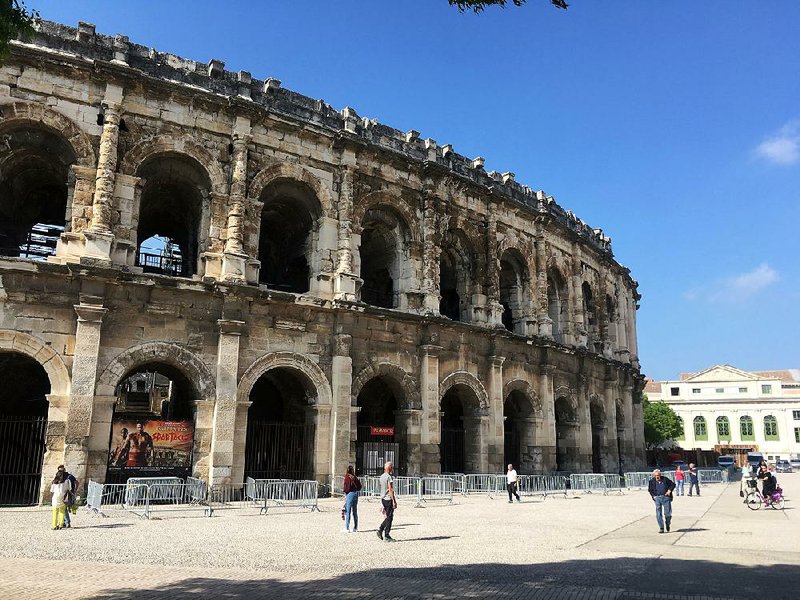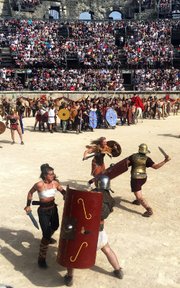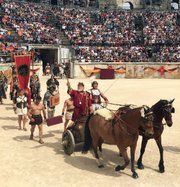A funny thing happened on the way to the Airbnb. As we dragged our suitcases along the cobblestones in the southern French city of Nimes, we saw a gladiator on a cellphone. The helmet-wearing warrior, looking straight out of ancient Rome, winked at my kids and kept marching toward the amphitheater.
Three hours by train from Paris, sun-soaked Nimes is home to some of the most immaculately preserved Roman monuments in the world. On his 1787 tour of France, a besotted Thomas Jefferson fell hard for the city's Roman grandeur. "Here I am, Madam, gazing whole hours at the Maison Carree, like a lover at his mistress," the third president wrote in a letter about the stately temple.
Where to eat
• La Bodeguita, Royal Hotel
1 Place d’Assas
Locals love this restaurant, packing the outdoor terrace situated on a central square.
• La Pie qui Couette
Rue des Halles
Inside the buzzing central marketplace (Les Halles), take a seat at the counter and order lunch from the chalkboard specials. The chef has worked in top restaurants across France, and now showcases the best local products found in Les Halles.
• La Piazzetta
2A Place du Chapitre
An authentic Italian restaurant serving pizza, antipasti, pastas, fish and meats overlooking a fountain of cascading pools. This square is beautifully illuminated at night, and the restaurant has an outside terrace for appreciating the ambience.
What to do
• Amphitheater of Nimes
Boulevard des Arenes
The world’s best preserved Roman amphitheater hosts events throughout the year, such as the Great Roman Games. Outside of these events, the amphitheater is open every day for visitors. Open 9 a.m. to 5 p.m. in the winter, and until 8 p.m. in July and August. A tour with an audioguide costs about $11.50. A pass gives access to the three Roman sites managed by Culturespaces — the amphitheater, Maison Carree and Tour Magne — for about $15 (valid for three days).
• La Maison Carree
Place de la Maison Carree
maisoncarree.eu/en
Called “square house” in French, this exquisitely preserved Roman temple is the beating heart of the city of Nimes. The building has inspired architects around the world. Inside, a film narrates the history of the temple. Opening hours vary throughout the year from 10 a.m. to 4:30 p.m. in the winter (with a closure for lunch) and from 9:30 a.m. to 8 p.m. in July and August. Admission costs about $7.
• La Tour Magne
Les Jardins de la Fontaine, Place Guillaume Apollinaire
Located inside the Jardins de la Fontaine, this Gallo-Roman tour once had views all the way to the Mediterranean in ancient times. Today you can climb to the top for beautiful views of Nimes. Open 9:30 a.m. to 4:30 p.m. in the winter (with a closure for lunch), and 9 a.m. to 8 p.m. in July and August. Admission costs about $4.
Information
And for the past nine years, the city has staged a spectacle that would make Augustus proud. In the same packed amphitheater where the Gallo-Roman population jeered and cheered at gladiatorial combat two millennia ago, Les Grands Jeux Romains, or the Great Roman Games, brings 500 re-enactment actors from all over Europe for a three-day event. We've arrived at the end of April for the Spartacus-theme edition.
This year's sold-out spectacle was particularly buzzing because of the amphitheater's new neighbor: The Musee de la Romanite, a highly anticipated museum that is hailed as one of France's biggest recent cultural projects. The museum, which cost about $65 million, is devoted to the civilization of ancient Rome and its legacy in Nimes. It was the brainchild of Mayor Jean-Paul Fournier, who has championed a contemporary urbanism that showcases the city's rich heritage.
"We wanted to create a museum that befits the quality of the city's 25,000-piece archaeological collection," Fournier wrote in an email, "including the exceptional mosaics and a Roman house discovered during an excavation in 2006."
Brazilian-French architect Elisabeth de Porzamparc beat out more than 100 other architects with a bold building draped in an undulating glass facade she has likened to a pleated toga. Explains Fournier: "For centuries, the architects in Nimes have drawn inspiration from the city's ancient edifices while anchoring their buildings in modernity, and de Porzamparc continues this process ... establishing a dialogue with both nature and the surrounding urban landscape."
Like Norman Foster's Carre d'Art, a contemporary art museum that overlooks the Maison Carree, the Musee de la Romanite has a restaurant (overseen by Michelin-starred chef Franck Putelat) with a view. You can admire the amphitheater from there or from the rooftop terrace.
Following the city's original Augustan ramparts, the museum's inner "street" is open to the public, so that visitors can freely enter the monumental 17-meter (about 55 feet) atrium, adorned with the temple pediment from the sacred spring where the pre-Roman settlement of Nemausus was founded. Inside the museum, visitors will find cool 3D renditions and virtual tours of ancient Gaul to enhance their understanding of objects such as the prized Pentheus mosaic. But perhaps the highlight is the archaeological garden. Free to access, it's designed as a plant museum, with species chronologically arranged according to when they were introduced to the region.
The landmark museum is a cornerstone of Nimes' campaign to become a UNESCO World Heritage site, the result of which will be announced this summer. "Roman history has profoundly influenced the Nimois, creating our city's identity and constituting our roots," Fournier said. "We share this common good in everyday life, and want to bring it to the world's attention."
. . .
Nimes came to my attention in 2006 via my first French friend, a Nimoise by the name of Marielle. As a Latin nerd, I found the city's monuments mesmerizing, but beyond that, it was the passionate personality of the place that won me over.
Consider Petanque, the game also known as boules. In Nimes, this is not a leisurely, pastis-soaked diversion, I quickly learned, but a ferociously competitive sport that requires great skill, passion, and calculation.
Attendance at one of the biannual ferias (festivals) quickly immerses a visitor in the loud and exuberant traditions of the city. In addition to the Great Roman Games put on by Culturespaces, the amphitheater hosts a number of events including rock concerts, tennis tournaments and la corrida, or bullfighting. This was a draw for Ernest Hemingway, who used to camp out and write at the Hotel Imperator (which is closed for an ambitious renovation).
The city's boisterous ambience isn't limited to its festivals. In the alleyways, cafes spill onto the sidewalks, and rowdy diners linger late into the evening. During the Great Roman Games, some restaurateurs dress up in togas and serve Roman-inspired meals. (We spy a few suckling pigs turning on a spit.) The atmosphere is so contagious that my gleeful 5-year-old takes off on a sprint through a narrow street, running smack into a dinner table, crashing its carefully arranged wine glasses to the cobblestones.
"Hannibal ad portas!" -- "Hannibal is at the gates!" -- is how parents in ancient Rome supposedly warned their kids to keep them on their best behavior. All I can manage is a shocked apology. But the waiter is too worried about Cecilia's possible injury, giving her a kiss and shooing me away when I try to pick up the shattered glass.
This love of kids is everywhere in Nimes. "There must be a mistake," we gesture to the waitress over the bill's two-euro price of two children's meals at the locally loved La Bodeguita, a lively restaurant on the Place d'Assas. "No, that's our owner's policy," she replied with a grin, bringing ice cream sundaes topped with glow-stick bracelets.
. . .
But bien sur, Spartacus was the real point of our trip.
We're transfixed. Emperor Hadrian is seated in pomp and circumstance, the crowd shouts a prayer to Jupiter ("Jovis Optimus, Jovis Maximus!"), horses race while 12,000 spectators cheer on their riders by waving color-coded napkins. Halfway through the spectacle, bread scented with orange blossoms is tossed from baskets -- just like the panem et circenses (bread and circuses) fed to the Gallo-Roman audience millennia ago.
My daughters are particularly awed by the female gladiators, whose swinging punches and action-packed combat cause a cloud of dust to rise in the ring. Not to mention the pageantry of the Spartacus story, told in eight episodes.
But above all, it's the historic accuracy that's awe-inspiring. The costumes are assembled with the same materials used in ancient Rome. The volunteers and professional actors -- such as Gilles Sindt, who plays Spartacus -- have trained rigorously for six months, many reading the works of historian Eric Tessier.
I've also been immersed in this history, via classicist Mary Beard's brilliant book SPQR: A History of Ancient Rome. In it she writes, "Rome still helps to define the way we understand our world and think about ourselves, from high theory to low comedy." Among many things, "Rome has bequeathed us ideas of liberty and citizenship" and "a vocabulary of modern politics, from 'senators' to 'dictators.'"
The Great Roman Games tell the story in such an intense way (slave markets, Sicilian pirates) that my older daughter Jane, wide-eyed with wonder, keeps asking me questions for days afterward. Meanwhile, I overhear Cecilia reciting the prayer to Jupiter in her bedroom, raising little palms upward to the heavens.
Travel on 07/08/2018



